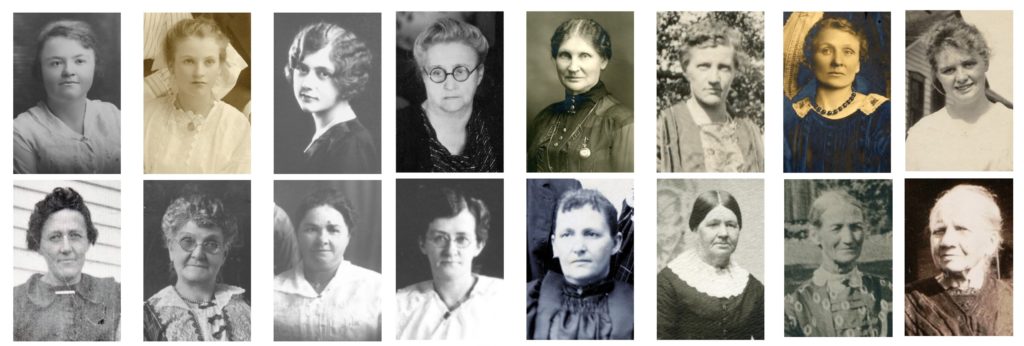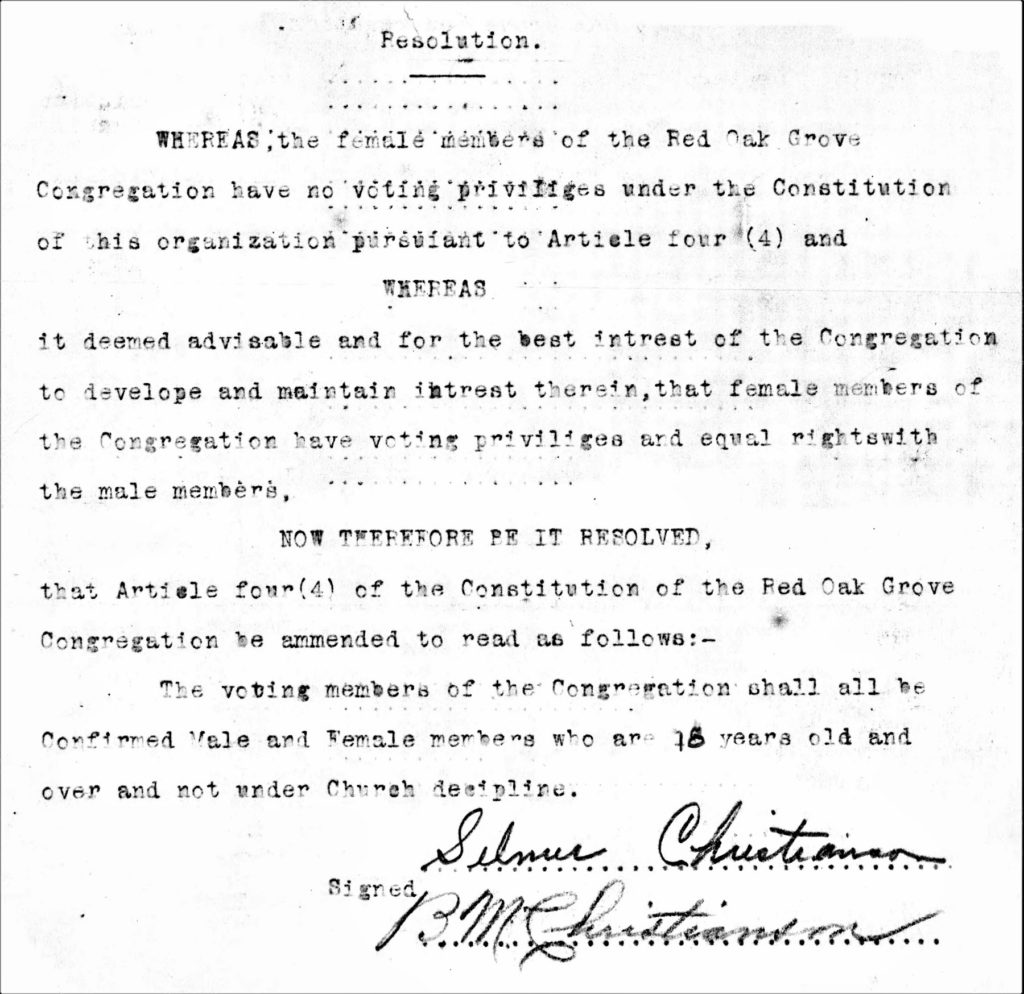As we celebrate the 100th anniversary of Women’s Suffrage in the United States, this series of posts puts the 19th amendment in context of our own ancestors.

“The right of citizens of the United States to vote shall not be denied or abridged by the United States or by any State on account of sex.”
19th Amendment
As we have seen in earlier posts, women fought to gain full voting rights, missed out on casting ballots in important elections, and had personal connections to the historic 1920 decision. But the fight did not end with the signing of the 19th amendment.
This is a revision of a post that was published a few years ago when I was shocked to find out sometimes women still couldn’t vote.
1951
1951 was the first year that my paternal grandmother and great-grandmothers could vote in their church. 1951.
1951!
We hear about women’s rights and frankly, I take it all for granted these days. Sure, as a woman working in corporate America for better than three decades, I ran into my share of discrimination. I shared an office with a guy for a while who told me that the reason unemployment was so high was because, “you da#n women think you have to work.” And, on too many occasions to remember, it was brought to the attention of all in attendance that I was the only woman in a meeting. It often went like, “@#$%! Oh, sorry, I apologize. I forgot we had a woman with us.” My male colleagues didn’t understand that it was more offensive to be singled out as the only female than it was to hear them curse. Heck, maybe I wanted to curse too. But through those rough work days, I just always remembered…

Smile.
For a few years, there were as many women around my office as men. In college, studying computer science, the ratio was nearly 50/50, or that is what I was trained to say giving tours anyway. And for a period of time in the early 1990s, I was on a couple teams where the men found themselves in the minority. They didn’t always like that. But, somehow we lost the progress we’d made and females fled from the technical professions. Today at the University of Minnesota, College of Science and Engineering, which houses the computer science major, only 25.8% of their graduate and undergraduate students are female. In contrast, the overall University of Minnesota population is 51% female. So, I do understand, given this one example, that we still have a long way to go toward becoming somewhat equal.
Suffrage
The 19th Amendment of the US Constitution, which was passed by Congress 4 June 1919 and ratified on 18 August 1920, gave women in the US the right to vote. It was signed into law on 26 August 1899, Leona Catherine Miller’s 21st birthday.
It took decades of protest and unrest to get this win for women. It is almost unfathomable to think of a world in which only men could vote.
I have to admit that due to the election madness of 2016 and the ensuing chaos, it might be nice to not have the right and responsibility to cast a ballot, but that is a whole different story. Things have gotten even more crazy since then.
I cannot imagine not having to pay attention to politics and issues because my husband (or father, or uncle, or brother, or some other male) would handle that for me since I was just a silly woman.
While my mom and I have always been eligible to vote, putting the date of the 19th amendment in context of my family, my grandmothers were the first to be able to vote in all elections. They became of legal age just as women got the vote. Three of my great-grandmothers got to vote. They were ages 39, 43 and 57 in August 1920. One second great-grandma was eligible to vote at age 68 and another at age 72. No other woman in my family tree was allowed to be a voting member of society.
So all this is well known history. Women fought and won the right to cast ballots. Hooray for women. End of story.
Red Oak Grove Lutheran Church

Well, maybe not the end of the story. As I was doing research for a book on my paternal ancestors, I found myself crawling through the records of our ancestral church. Amidst stories of the foundation of the church, Sunday school, Ladies’ Aid Society and such, there was the following highlight.
“During the past years, a resolution giving women the right to vote in congregational meetings had repeatedly failed to gain the two-thirds majority required for passage. The resolution finally passed in 1951 and the women’s right to vote was incorporated into the new By-Laws when adopted.”
Whoa! This little country church of which I’ve been so proud and fascinated didn’t let the ladies have a say until 1951? The church of my ancestors and baptism didn’t treat women equally until 1951? Thirty-one years after women could cast a vote in electing a United States president and they couldn’t vote on church matters? Wow! My grandmother was 49-years old by then. My great-grandmother was 74. Absolutely amazing! Who were these men who voted against this? (They were likely my relatives since nearly everyone in that church is related.)

Was Our Church Unique?
Looking into the matter to find out just how behind the times we were, I discovered that Red Oak Grove was actually decades ahead of some other Lutheran churches. While Red Oak Grove’s ELCA synod voted to allow women to be pastors in the 1970s, it wasn’t until 1969 that the Missouri Synod of the Lutheran Church allowed women to vote and in the Wisconsin Synod (WELS), women are still forbidden to be voting members. Unbelievable!
I am totally amazed that this discrimination against women can still be going on. Why do women continue to attend these churches? That is a rhetorical question. Evidently, some churches use a verse from Paul to continue to deny women rights.
As in all the churches of the saints, 34the women should keep silence in the churches. For they are not permitted to speak, but should be subordinate, as even the law says. 35If there is anything they desire to know, let them ask their husbands at home. For it is shameful for a woman to speak in church.
1 Corinthians 14:33-35.
In doing so, however, others argue that they ignore:
28There is neither Jew nor Greek, there is neither slave nor free, there is neither male nor female; for you are all one in Christ Jesus. 29And if you are Christ’s, then you are Abraham’s offspring, heirs according to promise.
Galatians 3:28.
To each his own, I guess. But, I’m very happy that I was brought up in a more progressive church and environment. I’d have a really hard time not speaking up.
Beyond 1951
Even though this was a relatively short time ago, finding this item in the church archives really got me wondering what else was affecting women back then. Some might argue these were simpler times for women and change is not always good, but since US women’s suffrage in 1920 and Red Oak Grove Lutheran women’s suffrage in 1951, we’ve also seen other major changes.
1964. Until the Civil Rights Act of 1964, it was perfectly legal to discriminate against women on the grounds of gender when considering whom to hire or promote. So a company could refuse to hire you simply because you were female.
1965. Before 1965 it could be illegal to use birth control. It wasn’t until 1965 that the Supreme Court made it illegal to ban married people from contraceptives, any type of contraceptives. Note that the birth control pill wasn’t approved for use for contraception by the FDA until 1960, and then it was made illegal in some states.
1969. Before the 1969 No Fault Divorce law, divorce could only be obtained if you proved your spouse had committed serious faults such as adultery.
1971. Until 1971, women could be denied the right to practice law, even if they had qualified as lawyers, purely because they were women. Barring women from practicing law was only prohibited in the US in 1971.
1972. The Boston Marathon wasn’t open to women runners until 1972.
1973. It wasn’t until 1973 that women could serve on juries in all 50 states. Some states allowed it, but others didn’t. The main reason to keep women off juries was to keep them at home. Their primary responsibility was that of caregiver to their families and homes, so they were kept out of jury pools. They were also thought to be too sensitive to hear details of grisly crimes.
1974. Until “The Equal Credit Opportunity Act of 1974,” a woman could not necessarily get a credit card. If she was single, she could be refused a card. Period. And, if she was married she would need to get her husband to co-sign and it may be required to be in her husband’s name.
1976. Women couldn’t attend any US military academy until 1976.
1977. It was 1977 before workplace sexual harassment was recognized as an offense. Before then you could not legally fight being sexually harassed on the job. Of course, the Me Too movement shows that a lot of men didn’t seem to get the news about this being against the law.
1978. In the US it wasn’t illegal to lay off female employees because they were pregnant until 1978.
2012. Women couldn’t box in the Olympics until 2012.
2014. Women couldn’t enter any Olympic ski jumping events until the 2014 Olympics.
There are several things on this list that some may disagree with and there are many that I don’t personally care to do myself (divorce or ski jump, for example), but it is a good reality check to understand that there were things that we take for granted that our mothers, grandmothers, great-grandmothers, etc. were not allowed. It may also explain why Grandpa may make a seemingly sexist remark now and then.
Still not always fair
Things are still not always equitable. Women don’t make as much money, “girl things” cost more, women don’t have equality in the board room or the news media or tech companies or Hollywood, women still do most housework, women still fear sexual assault… The list goes on and on. If you pay attention, you can hear about the inequalities often in the news.
It would take many more posts to adequately cover all the inequities, so this is limited to just a few examples.
It costs more to be a girl
Women pay more for common items than men.
To get two disposable razors, a gal has to spend considerably more than a man does to get four.

Look, a women’s basic white t-shirt is cheaper! Look again. Men can get three for $9.99 which equates to $3.33 per shirt. Women pay $6.01 for one.

Things cost more for the ladies.
Women earn less
Things cost more, yet women earn less. Despite an equal pay law being in effect for over 50 years, women continue to earn only about 80 cents for every dollar their male counterparts make. There are lots of excuses. for example, jobs traditionally held by females often pay less and women often take a career hit when they are parents. Maternity leaves can derail a career. The pandemic is causing many women to leave their jobs to stay home with their kids.
Taxation without representation
Women also have not reached equality in government. Remember all those old white men that we learned about as candidates in the 1868-1920 elections?
Guess what?
The candidates for the 2020 election are both old white men (really old, actually).
One hundred years after the signing of the 19th Amendment and women still don’t have an equal voice in government. We’ve never had a female president. We haven’t even had a female vice-president.
Thus far only 57 women have ever served in the United States Senate. Right now, only 26 of the 100 US senators are female. That is only 26%.
Yet, 50.8% of the population is female.
It’s worse in the house. Only 23.7% of the US Congress is female.
Only nine of our fifty states have female governors right now. And three of them got the job when the elected governor resigned or took another job.
Women have a long way to go to achieve equal representation!
The end of our suffrage story
As our women’s suffrage story comes to an end, I’m glad that the 19th amendment was signed in 1920, giving women full voting rights. I’m certainly glad that my male relatives at Red Oak Grove came to their senses in 1951. I hope that things will continue to progress and women will someday be considered equals.
Researching your family history can lead you to interesting tidbits that get you thinking of topics you’ve never explored. Thinking through an event and its associated dates, and then contrasting that with the ages of your family members at the time, can give you a much better understanding of how life really was for your ancestors. In other words, putting history in context of your ancestors can help you understand both your family and historical events.
Sources:
“17 Crazy Things Women Couldn’t Do in 1960.” Web. 22 March 2016. http://offbeat.topix.com/slideshow/15483.
“19th Amendment to the U.S. Constitution: Women’s Right to Vote.” National Archives. Web. 22 March 2016. http://www.archives.gov/historical-docs/document.html?doc=13.
Ancestry.com, Evangelical Lutheran Church of America, Vital Records, 1875-1940 (Provo, UT, USA, Ancestry.com Operations, Inc., 2015).
“CSE: By the numbers.” College of Science and Engineering, University of Minnesota. 17 November 2015. Web. 22 March 2016. https://cse.umn.edu/r/cse-by-the-numbers/.
McLaughlin, Katie. “5 things women couldn’t do in the 1960s.” 25 August 2014. Web. 22 March 2016. http://www.cnn.com/2014/08/07/living/sixties-women-5-things/.
Pearl, Diana. “14 Things Women Couldn’t Do 94 Years Ago.” Marie Claire. 18 August 2014. Web. 22 March 2016. http://www.marieclaire.com/politics/news/a10569/things-women-couldnt-do-1920/.
“Raising Up Strong Women.” Progressively Lutheran. 20 April 2010. Web. 22 March 2016. https://progressivelylutheran.wordpress.com/tag/womens-rights/.
The Holy Bible. Revised Standard Edition. The Melton Book Company: Dallas, 1952.
“WELS Constitution and Bylaws of the Wisconsin Evangelical Lutheran Synod and the Constitution for the Districts Published by The Wisconsin Evangelical Lutheran Synod N16W23377 Stone Ridge Drive, Waukesha, Wisconsin 53118 Issued by The WELS Committee on Constitutional Matters Adopted July, 1997 Amended July, 1999, August 2001, August 2003, August 2005, August 2007, August 2009, July 2011, August 2013, and July 2015.” WELS. 2015. Web. 22 March 2016. http://synodadmin.welsrc.net/download-synodadmin/official-synod-reports/?wpdmdl=3263&ind=slcfzzOLs4JlcQI3XpqsGEgefW3p8QPGx1fyTR6QbVyGLOK0H4T-t39c9lZ_UYRE.
Red Oak Grove Lutheran Church, Austin, Minnesota, U.S., Evangelical Lutheran Church in America Church Records, 1781-1969, Image 80 of 938, Ancestry.com (accessed 09 Jul 2020).
Red Oak Grove Lutheran Church, Austin, Minnesota, U.S., Evangelical Lutheran Church in America Church Records, 1781-1969, Image 438 of 938, Ancestry.com (accessed 09 Jul 2020).
Megan Friedman, Jenny Hollander, and Ineye Komonibo, “18 Ways Women Still Aren’t Equal to Men,” Marie Claire, 9 Aug 2019 (https://www.marieclaire.com/politics/news/a15652/gender-inequality-stats/ : accessed 24 Jul 2020).
“Quick Facts,” United States Census (https://www.census.gov/quickfacts/fact/table/US/LFE046218 : accessed 24 Jul 2020).
“Women in the U.S. Congress 2020,” Rutgers (https://www.cawp.rutgers.edu/women-us-congress-2020 : accessed 24 Jul 2020).
“Women in Statewide Elective Executive Office 2020,” Rutgers, (https://www.cawp.rutgers.edu/women-statewide-elective-executive-office-2020 : accessed 24 Jul 2020).
“Equal Pay & The Wage Gap,” National Women’s Law Center (https://nwlc.org/issue/equal-pay-and-the-wage-gap/ : accessed 24 Jul 2020).
Rachel Donadio, “The Coming Setback for Women in the Workplace,” The Atlantic, 28 May 2020 (https://www.theatlantic.com/international/archive/2020/05/france-women-workplace-coronavirus-pandemic/612136/ : accessed 24 Jul 2020).
Lauren Weber, “Women’s Careers Could Take Long-Term Hit From Coronavirus Pandemic,” The Wall Street Journal, 15 Jul 2020 (https://www.wsj.com/articles/womens-careers-could-take-long-term-hit-from-coronavirus-pandemic-11594814403 : accessed 24 Jul 2020).


One response to “Suffrage: 1951”
Thank you for these articles. They are interesting to read! It’s hard to believe that there are countries that still don’t give rights to women, that they are treated as property. Makes me thankful for being born in the United States.